This article is about how to install wall tile in bathroom. The bathroom is one of the most important areas in our home, so we have to make everything possible to turn it into a cozy and neat space, by learning how to tile the walls. You have to use proper materials, as to protect the bathroom walls from the constant humidity and heat, which can damage the structure of our homes. In order to install the wall tiles properly, one has to know several basic techniques regarding this project: how to cut tile, how to set the wall tile layout, how to prepare tile adhesive or how to lay ceramic tiles. Therefore, you have to pay attention to all these aspects before tiling a bathroom by yourself and read carefully all our articles regarding ceramic tile.
You have to prepare thoroughly the walls before installing tile in bathroom. Make sure the walls are straight and level, without any irregularities or residues, otherwise the tiles won’t stick to walls or you could end up with a crooked wall. In addition, if you have to install wall tiles on drywall, you should prepare the surface thoroughly. Therefore, make sure you have installed green drywall (designed to resist water and moisture) or even better cement boards, in the areas exposed to moisture. These sheets of cement are made of materials which do not absorb water, making them the proper solution for your bathroom walls exposed to moisture.
The cement boards have to be secured with galvanized screws (to prevent them from rusting) to the structural studs, in the same manner as a regular drywall boards (use a stud finder to know were to drive in the screws). In addition, you have to use special fiberglass tape to mask and protect the joints between the boards. Remember that in the shower area, you have to insulate thoroughly the wall against moisture, so it is compulsory to use these cement boards. If your bathroom walls are covered with paint, you have to remove it, otherwise the tiles won’t stick to the surface. In addition, use sandpaper and a special solution (according to the type of paint), to remove the paint from the walls. After you have finished removing it, you have to clean the dust or residues off the wall.
Made from this plan
In order to install wall tile in bathroom, you need the following:
Materials
- Ceramic tiles
- Trim tile (optional)
- Plastic corner trims (for exterior and interior corners)
- Tile spacers
- Thinset
Tools
- Safety gloves, safety glasses
- Measuring tape, framing square, pencil
- Score-and-snap tile cutter, tile nippers
- Notched trowel, margin trowel
- Bucket, mallet, spirit level
Tips
- Decide the tile layout before installing it
- Check if the walls are plumb, after laying the wall tile
Time
- 6-8 hours for a surface of 100 ft2 / 10 m2, one diy-er
How to install wall tile in bathroom
On the market, there are many products to choose from, so try to buy the tiles which fit best your needs and tastes. Nevertheless, make sure the bathroom tiles are designed to resist against water. Strange as it might seem, there are several types of ceramic tile that are not water-resistant. Consequently, pay attention before buying the ceramic tile from your local store. In addition, before placing the order, you have to measure the surface on which you are going to install tile (multiply the total length by the height of the wall), and add 10-15% for cutting waste.
Wall tile layout
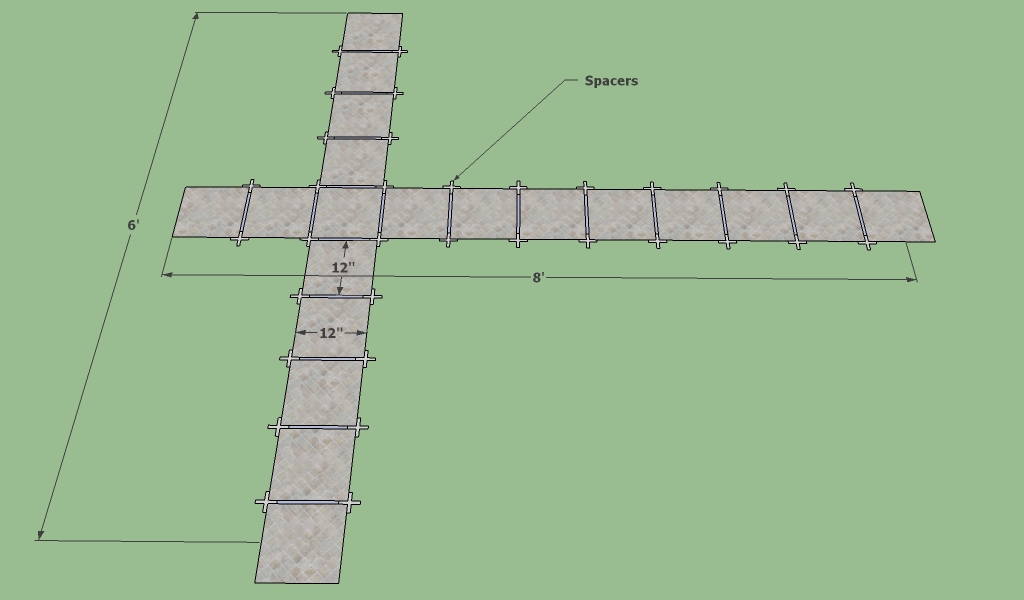
Tile layout
Measure the height from the floor up to the ceiling. Then, lay your tiles on the the floor in a straight line, making sure you put spacers between them. Next, use a tape measure along the tiles to see how much you have to cut from the first row of tiles (you should install full tiles on the last row). In addition, you have to measure the width of the walls, to see how much you have to cut from the tiles around the corners. The tiles have to be wider than 2”/5 cm, otherwise you have to compensate from the opposite corner tile.
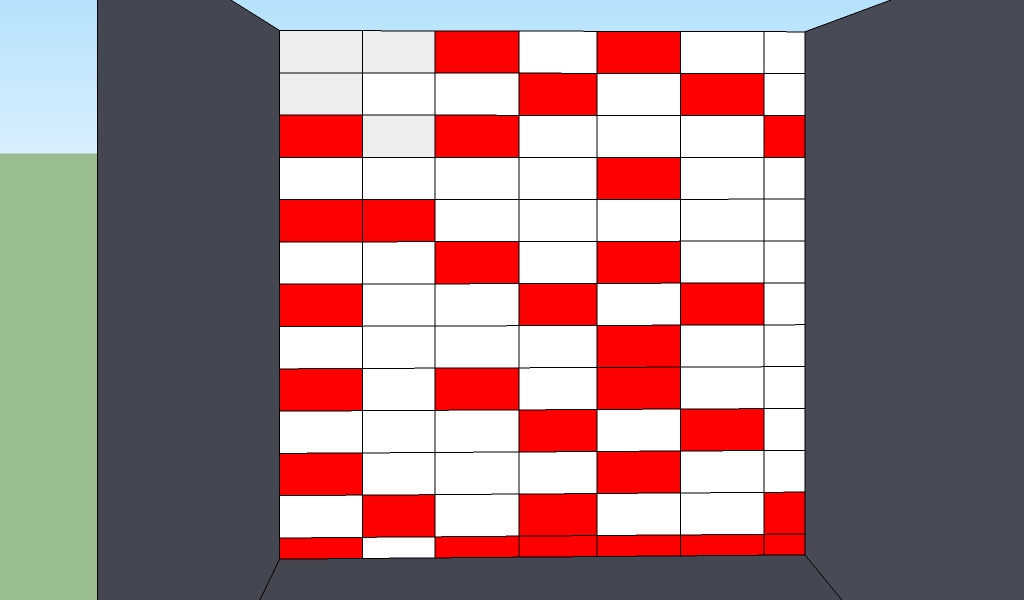
Wall layout
We recommend you to set up the layout of the wall tile from the very beginning. You can draw the layout on paper, or by using a computer software. In our case, we used Sketch-up to draw a random layout.
Spreading adhesive on bathroom wall
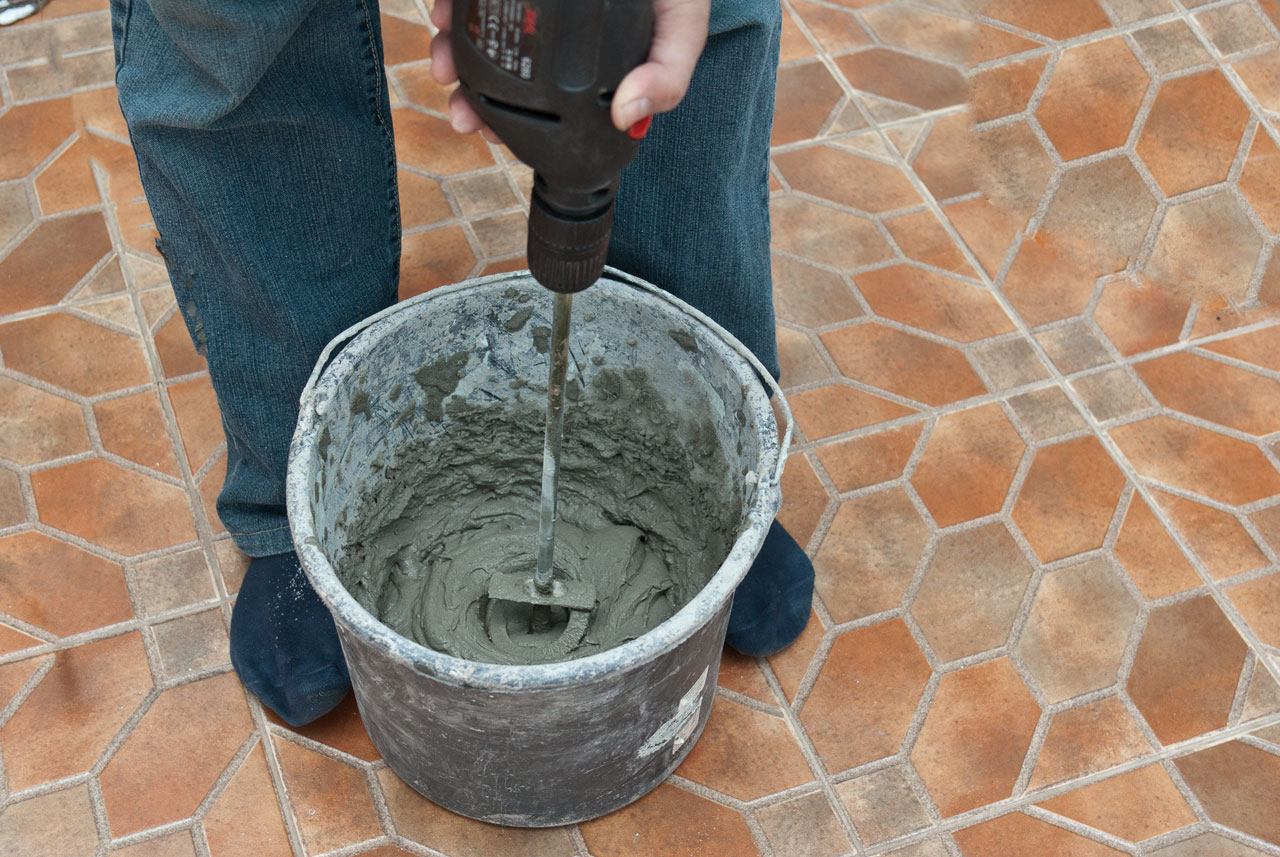
Mixing tile adhesive
Mix a small quantity of tile adhesive in a construction bucket. Fill about 1/4 of the bucket with clean water and pour the thinset powder. Then, you should leave the adhesive to soak water for 5 minutes. In this manner, the water will activate the additives in the thinset.
Next, use a drill machinery with a mixing paddle to prepare the adhesive. Use your feet to lock the bucket into position, while you mix the adhesive with the paddle. From our experience, we recommend you to use average speeds at first and then increase it if needed.

Spreading out adhesive on wall
After you have prepared your bathroom walls, you can start installing the tiles. If the adhesive doesn’t fall of the trowel, it means that it has the right consistency.
Load a little adhesive on the trowel and use the straight edge to spread it on the wall. After you’ve got an even layer of adhesive, you should use the notched edge to comb it. Hold the trowel at 45º against the wall and press firmly, as to make sure the mortar bed is evenly distributed on surface.
Installing tile on bathroom wall

Installing tile in bathroom
Start installing the first row of full tiles from the most visible corner, when entering the bathroom door. Make sure the tiles are not scratched or nicked before you install them over the adhesive bed. Select only the best tiles, to get a neat look.
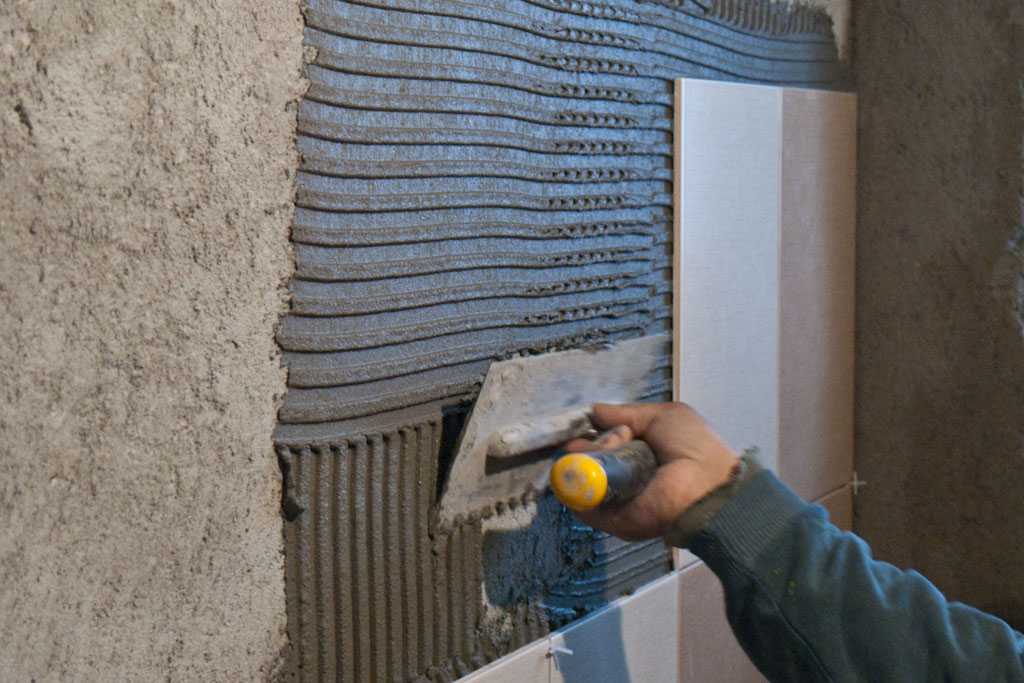
Spreading out adhesive on bathroom wall
Continue spreading out the adhesive on small surfaces (as to prevent it from getting dried before you install tiles on the whole area), using the notched trowel. The pattern of the adhesive ridges is not important, provided the bed of mortar is even on the whole surface.
Installing wall tile spacers
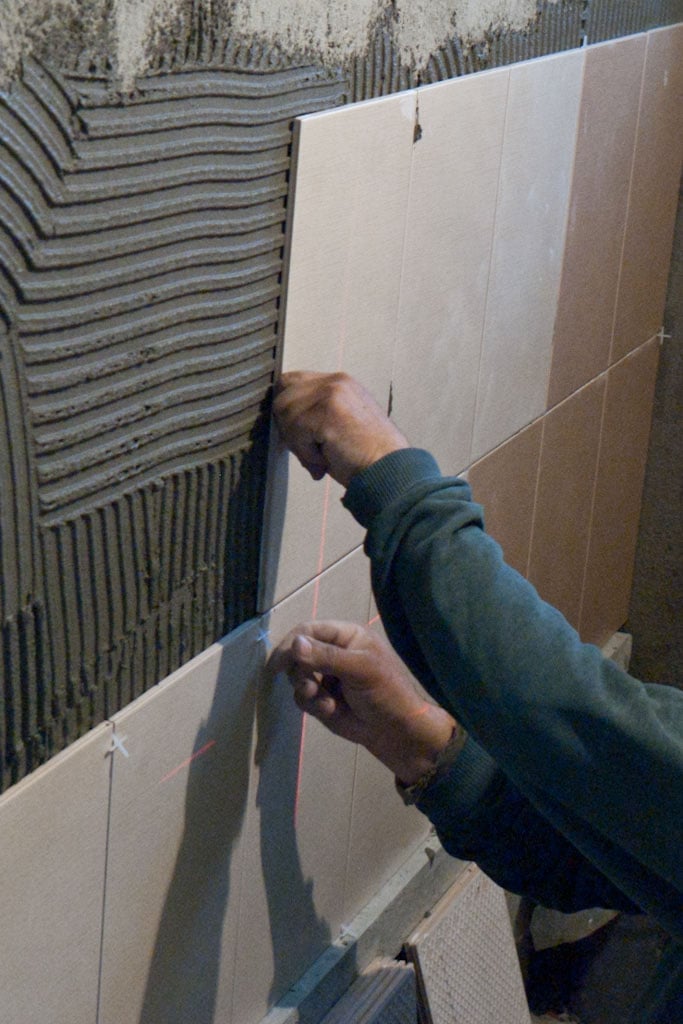
Installing wall tile spacer
It is impossible to install wall tiles in bathroom properly, without using the right spacers. Generally speaking, tile spacers come in a large variety of dimensions, so it is up to you the type of tile you are using. Similarly, you could install small or large spacers.
The main role of the tile spacers is to help you maintain an even gap between the tiles and to ensure the joints are consistent. Work with great care and install the spacers every time you lay a tile on the bathroom wall.

Installing wall tile in bathroom
In this image you can see an intermediary stage of our project. Consequently, you can notice the tiles are all level and the joints are even due to the proper installation of spacers. The tile pattern is not important, but if you use tiles of different colors, it is essential to decide the pattern from the very beginning.
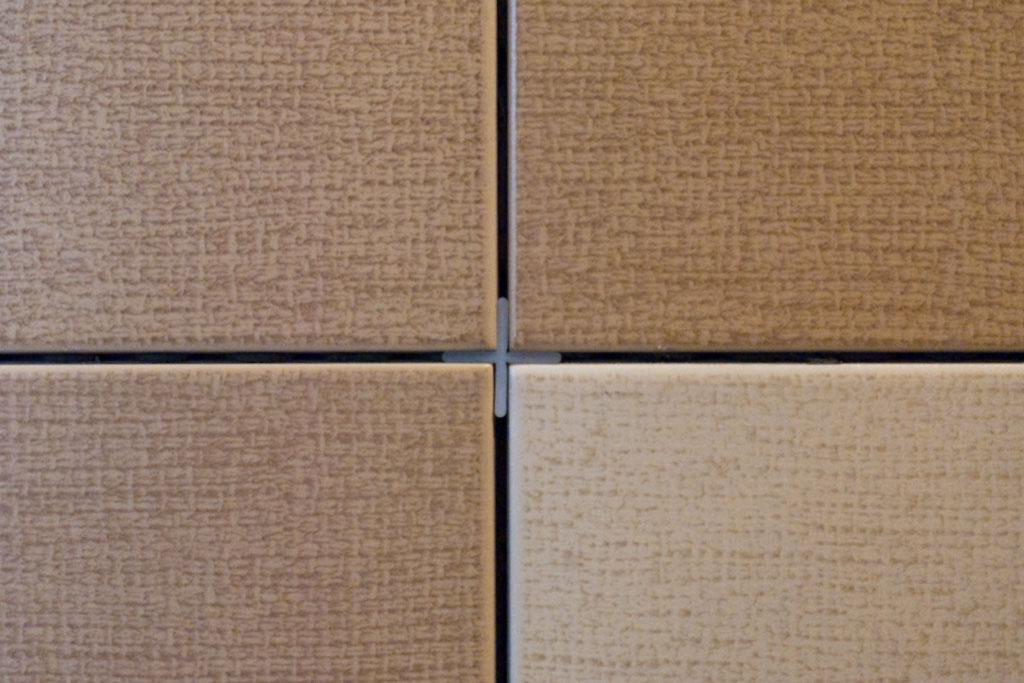
Wall tile spacer
In this image you can see a close-up of a tile spacer. You should be able to notice that a tile spacer plays a fundamental role in the success of any tile project: it helps you install tiles properly and keeps the gaps even.
Installing tile corner joints
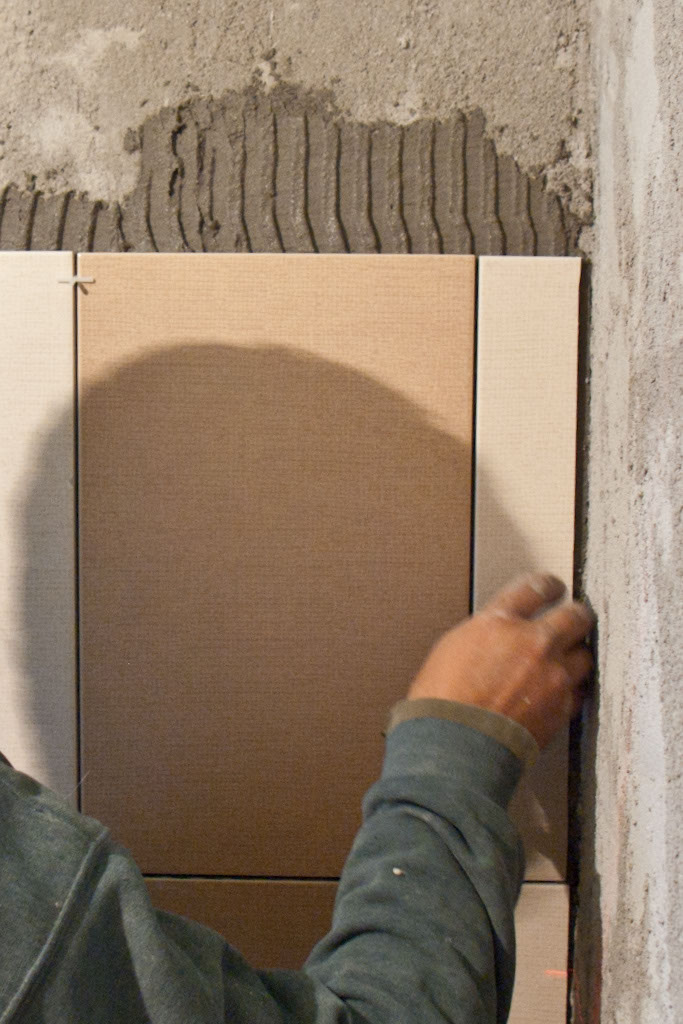
Installing cut tile in corner
In most of the cases you have to cut the tile as to fit along the wall corners. Consequently, use a tape measurement to determine the dimension at which you have to cut the tile. Afterwards, you could use a score-and-snap cutter, a diamond blade or a wet saw, to make the cut in a professional manner.
The tile corner joints are very important when installing tile in your bathroom, as they are extremely visible, so you have to pay attention to this procedure. For an unique look, you can install corner trims, but make sure they match with bathroom tile.
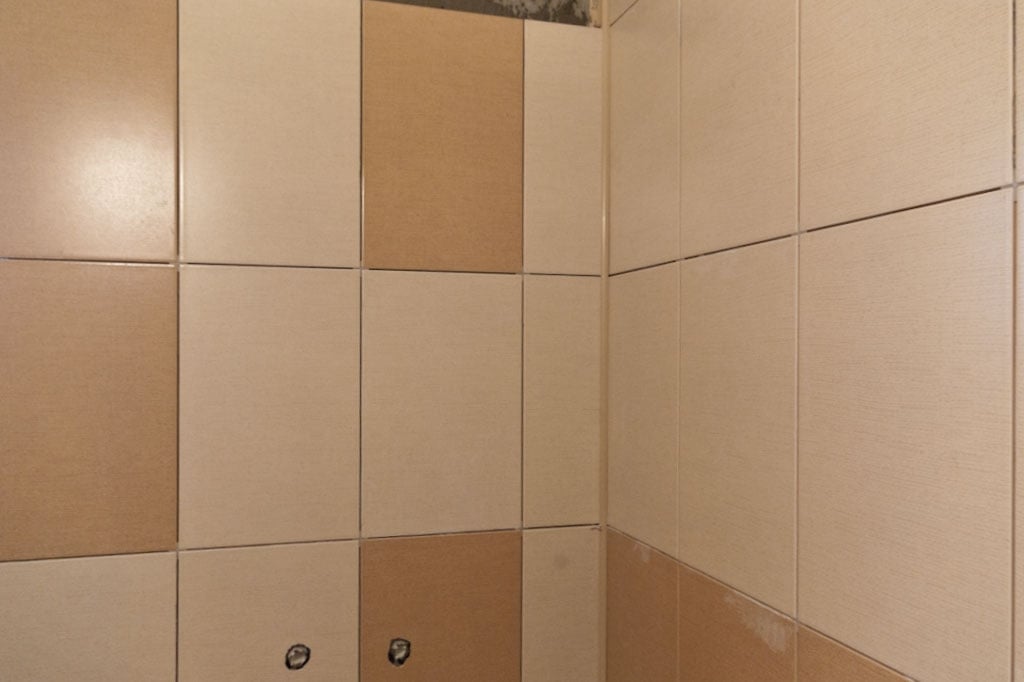
Tile corner joint
In this image you can notice the corner trim installed. We personally prefer the traditional way of installing corner tile, but it is up to your tastes. The greatest advantage of using corner trims is that it hides the poor cuts.
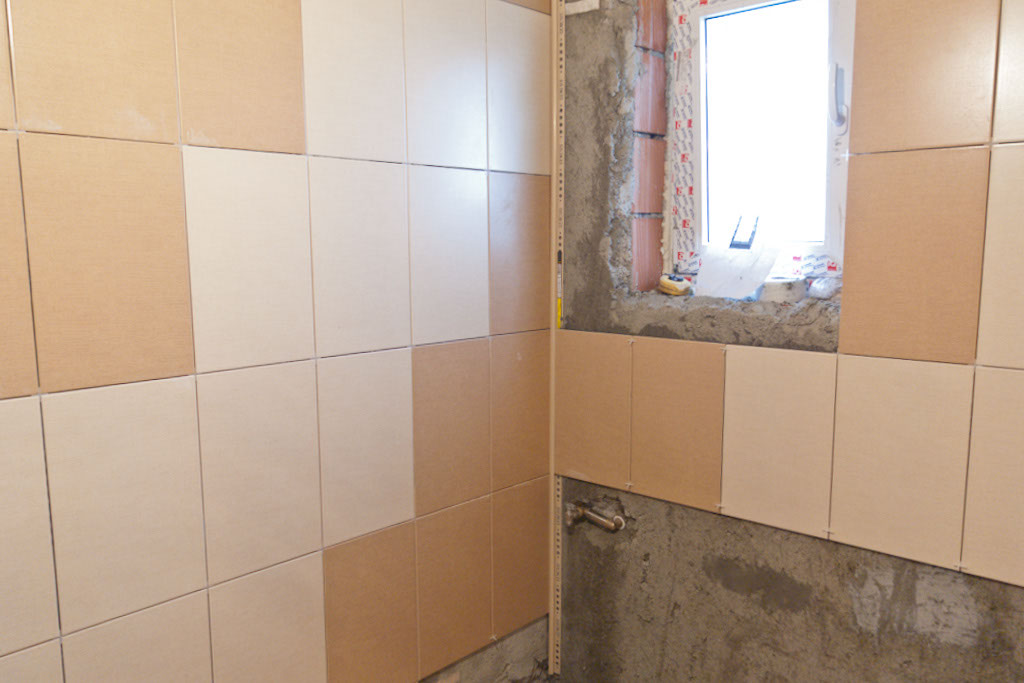
Installing tile around bathroom window
Next, we also have to install tile around the bathroom window. This step is a little bit more difficult, as it implies a lot of measurements and cuts. Nevertheless, if you are using a level and a proper tile cutter, you won’t face any issues while tiling around the window.
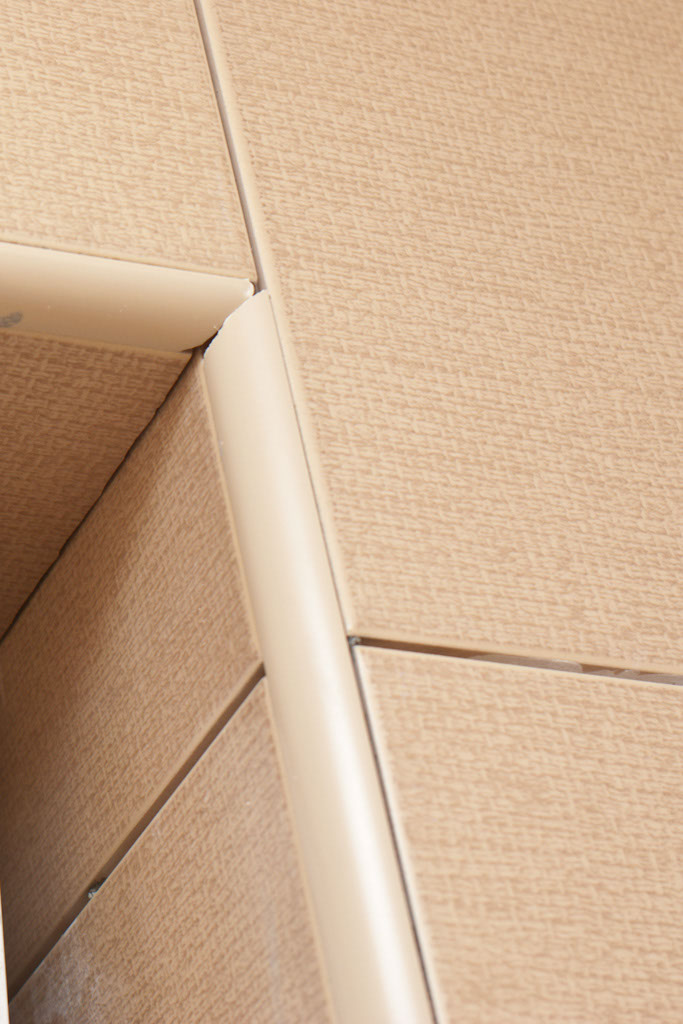
Exterior tile corner joint
There are more types of corner trim, on one hand there are interior corner trims, as on the other hand there are exterior corner trims. According to your needs and tastes, you can install both of these corner trims.
In addition, you can notice that the gaps between the tiles are continuous, even if we speak of the bathroom window. Use the edge of the trowel to clean the adhesive between the tiles, making sure you don’t move them from position. From our experience, we recommend you to clean the adhesive residues after several hours from the tile installation.
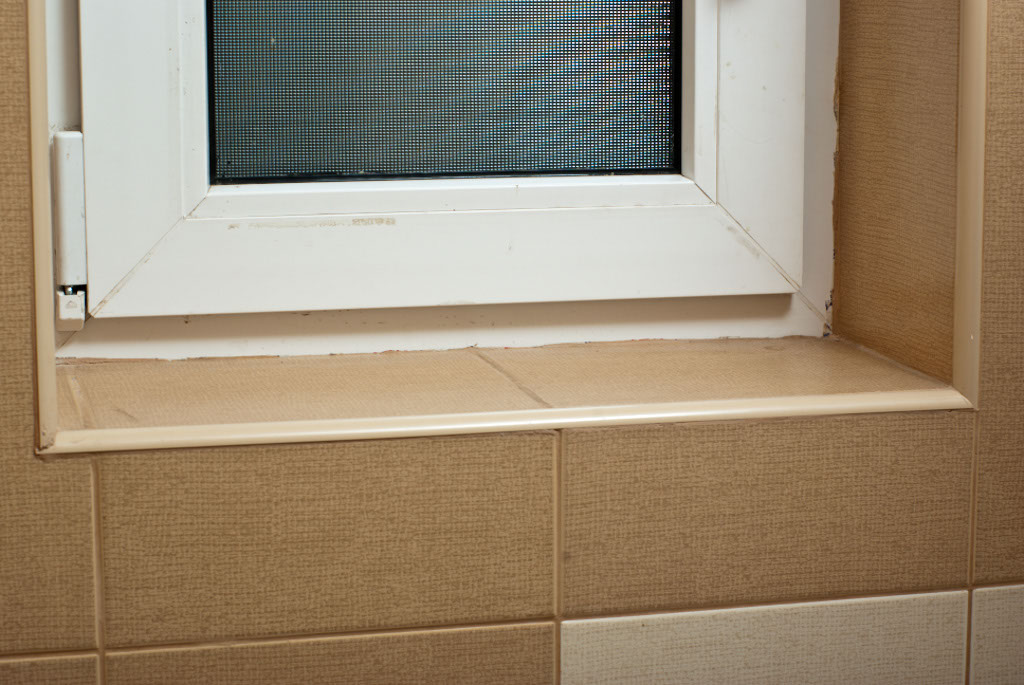
Installing tile around window
After you clean the tiles and grout them, your bathroom window will look neat. Nevertheless, you could choose not to install tiles around the window, but we think that not only it would look better, but it also protects the walls from moisture and impacts. Therefore, you’ll see the results over time.
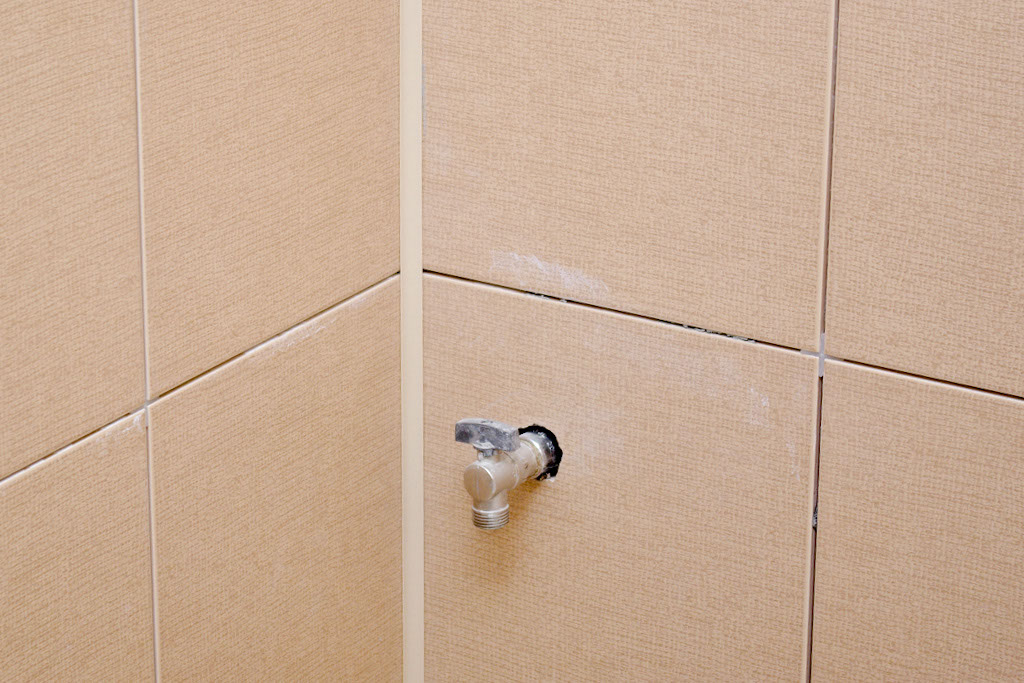
Cutting round hole in tile
When tiling the bathroom walls, you will face certain situations when you have to cut around pipes, drains or other obstacles. Consequently, you should use a hole saw drill bit, as to cut a perfectly round hole.
Installing the last row of wall tile in bathroom
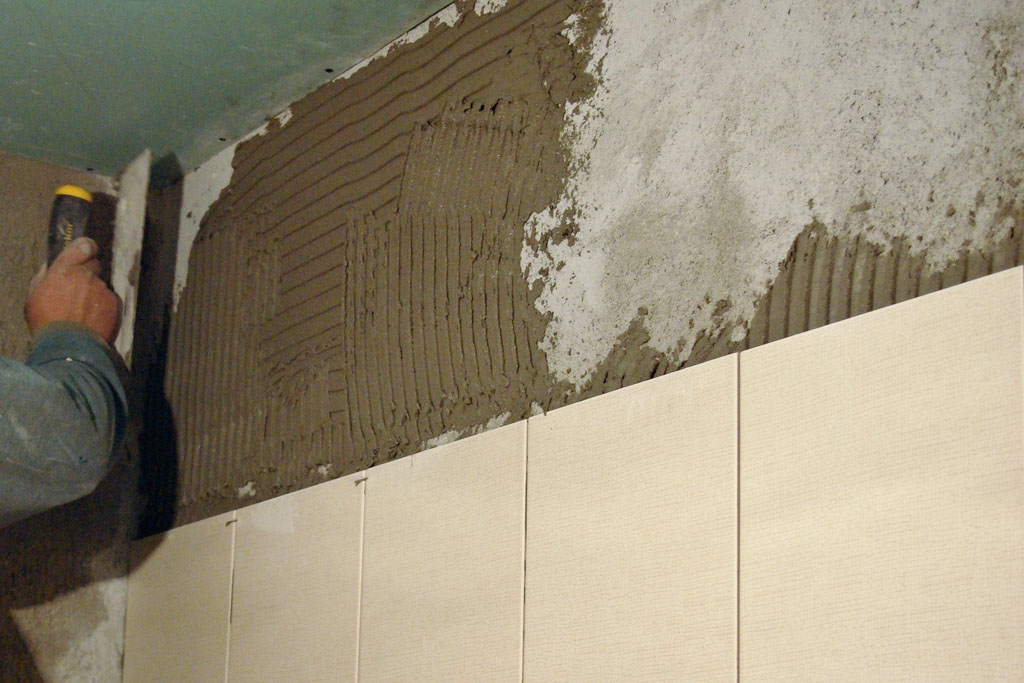
Installing last row of tile in bathroom
As we have already emphasized, you should install full tiles on the last row, as it is the most visible area from any corner of the bathroom. That is why, you have to make good calculations, before you start installing the tile in your bathroom, otherwise you might have to make additional cuts .
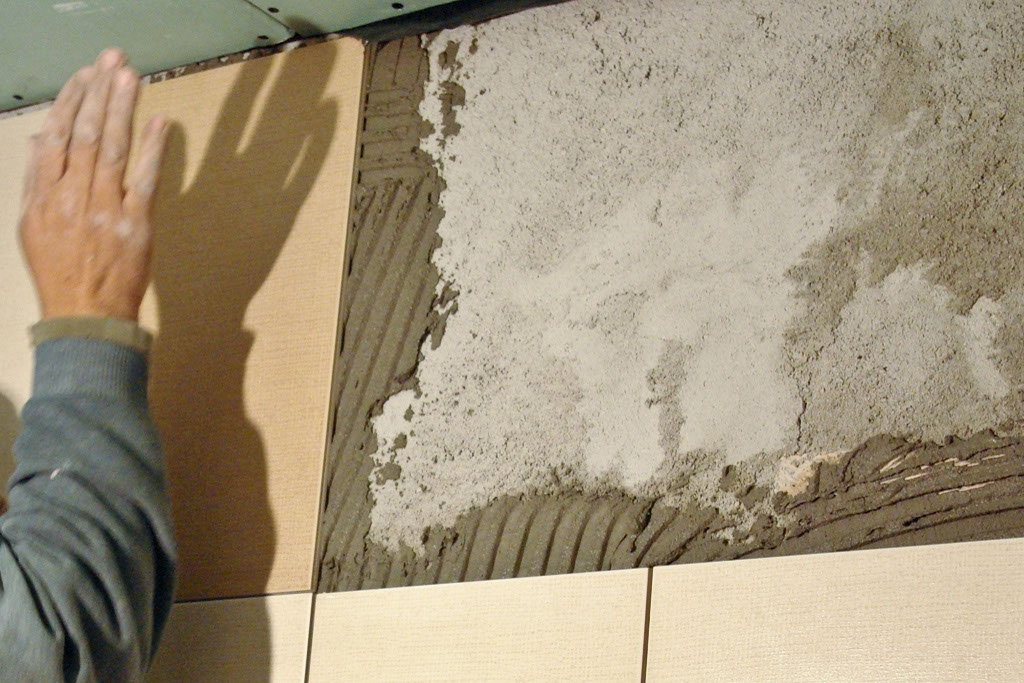
Tapping wall tile
In order to fix the tiles on position, you have to tap them either with a rubber mallet or by using your hand (we don’t recommend you to use this method, as you could injure yourself).
Use the level to check the alignment of the tiles, as after the adhesive dries out, it would be impossible to fix the problem. Use spacers to make sure the tile joints are even.
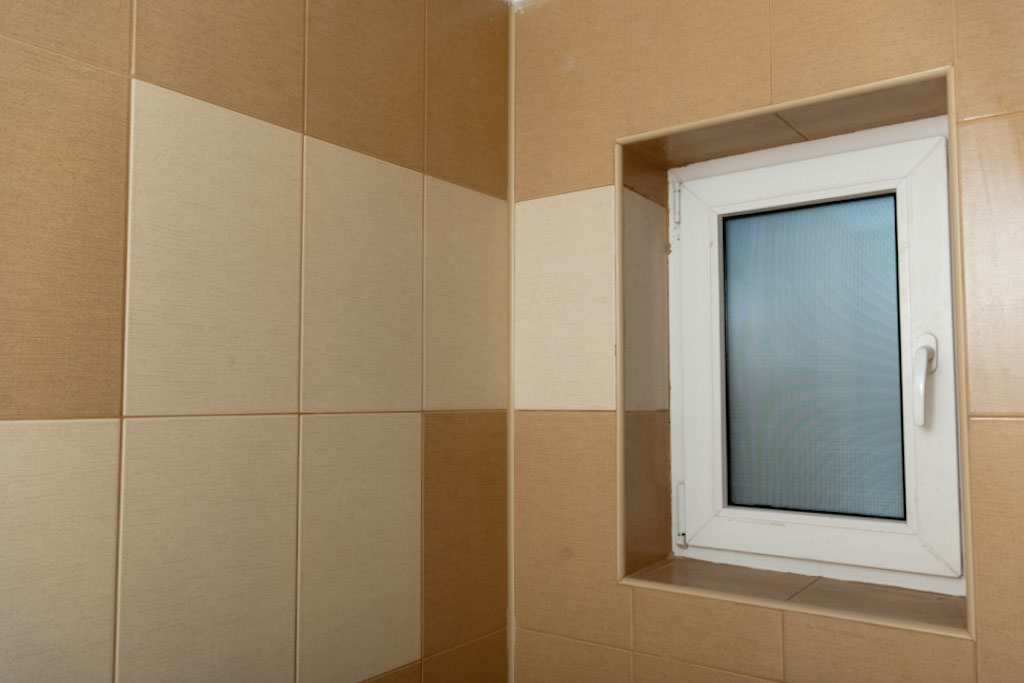
Wall tile in bathroom
After you have completed tiling the bathroom walls, you should also grout the gaps between the ceramic tile rows. You should also use a sponge and a bucket with clean water, to remove dust and residues off the tiles. In addition, use appropriate products to freshen up the look of your bathroom, every week.
Best tips to tile a bathroom:
Installing wall tile in a bathroom is a great way to add durability and style, but it requires proper preparation and technique. Here are my best tips for getting the job done right:
1. Prepare the Surface: Ensure the bathroom wall is clean, dry, and smooth. For wet areas like showers, you’ll need to install a cement backer board instead of drywall to provide a moisture-resistant surface. Make sure the backer board is flat and well-secured before tiling.
2. Plan Your Layout: Before you start tiling, plan the layout by dry-fitting a few rows of tiles. This helps you avoid awkward cuts and ensures a symmetrical design. Starting from the center and working outward often gives the best visual result. Use tile spacers to maintain even gaps for grout lines.
3. Use a Level: When tiling a wall, gravity can cause tiles to slip out of place. Use a level to draw horizontal and vertical reference lines on the wall to keep your rows straight and even. Install a ledger board along the bottom row to support the weight of the tiles and keep them from sliding down.
4. Apply Thinset Evenly: Use a **notched trowel** to spread a layer of thinset mortar on the wall in small sections. Spread only as much mortar as you can tile over within 10-15 minutes. Hold the trowel at a 45-degree angle to create ridges that will help the tile adhere securely.
5. Use Tile Spacers: Insert tile spacers between each tile to maintain even grout lines and prevent the tiles from shifting. Use the appropriate size spacers based on the look you want, and make sure to remove them once the tiles have set.
6. Cut Tiles for Fit: Measure and mark tiles that need to be cut to fit around corners, fixtures, or edges. Use a wet saw or tile cutter for straight cuts, and tile nippers for smaller, more detailed cuts around obstacles like pipes.
7. Work in Small Sections: Tiling in small sections gives you more control and prevents the thinset from drying out too quickly. Start with one wall at a time, and make sure tiles are level and properly aligned before moving to the next section.
8. Let the Tile Set: Allow the tiles to set for at least 24 hours before applying grout. This gives the thinset time to fully cure and ensures a strong bond between the wall and the tile.
9. Grout and Seal: Once the tiles have set, apply grout to the gaps between tiles using a rubber grout float. Work the grout into the joints at a 45-degree angle to ensure even coverage. After the grout dries, wipe off the excess with a damp sponge, and once it’s fully cured, apply a grout sealer to protect against moisture and stains, especially in high-moisture areas like showers.
10. Caulk Edges: Use silicone caulk along the edges where the tile meets the bathtub, countertop, or walls. This ensures flexibility and water resistance in areas prone to movement or moisture exposure.
Thank you for reading our article on how to install wall tile in bathroom and we recommend you to check the rest of our projects regarding ceramic tile. Don’t forget to share our projects with your friends by using the social media widgets. LIKE us to be the first that gets our latest projects and to help us create more free tutorials.


9 comments
How do you install tile on a uneven wall
You need to level the wall first.
Great job!
I would like to find someone able to install tiles on my bathroom walls, too!!!
ob
Thank you for the compliments! I am sure there are many qualified professionals in your area. However, if you don’t find anyone with good recommendations, you can always undertake this as a DIY project.
Rather than using a notched trowel to apply the thin set to the DurRock cement board, or to the back of each tile, my install placed globs of thin set to the center of each tile and pushed it into place. Each large (12×12 and 12×24) now has a space all along the perimeter of each tile. I did not discover this until most of the tiles were installed.
What problems might I have over time, e.g., moisture, mold cracked tile, etc.
Thanks so much.
Both techniques are acceptable, so if the surface is plane and if the gaps are grouted properly, I wouldn’t worry too much. The thing is there are some walls where the surface is not even, so you can spread the thinset with a notched trowel. Maybe that’s why they used this technique. Just make sure they seal the gaps properly, so water cannot get behind the tiles, where there is no thinset.
Is it possible to use only cement as tile adhesive on bath room wall?
No. That would be a huge no.
Jack, I’ve already started tiling the shower / tub wall, and as I’ve progressed up the wall, all of a sudden I’ve noticed the tiles are not meeting the other edge. This make me believe that the distance between the opposing walls, are not equal as I progress up the wall. I never thought to measure the distance, going up the wall, to insure that it was equal all the way up. Any suggestions?